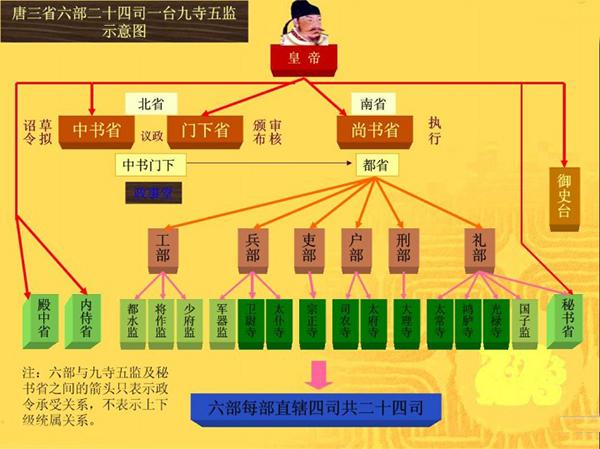(单词翻译:单击)
Tang Dynasty
唐朝
Establishment
唐朝的建立
Li Yuan, who was a former governor under the Sui dynasty rose in rebellion after being urged on by his second son (later Tang Taizong).
李渊原先是隋朝的一名官员,在自己的二儿子(后来的唐太宗)的力劝之下,他在农民起义中揭竿而起。
Li Yuan installed a puppet child emperor of the Sui dynasty in 617 but he eventually removed the child emperor and established the Tang dynasty in 618.
李渊于617年扶立了隋朝的一位幼年天子作为傀儡皇帝但是最终他取而代之并在618年建立了唐朝。
Li Yuan ruled until 626 before being deposed by his son, Li Shimin, known as “Tang Taizong” in history.
李渊在位八年,626年时被自己的儿子李世明,也就是历史上的唐太宗罢黜。
Taizong then set out to solve internal problems within the government, internal problems had constantly plagued past dynasties.
太宗之后开始着手解决政府的内部问题,这些问题在之前那些朝代一直是一个麻烦。
The Emperor had three administrations (省, shěng), which were obliged to draft, review, and implement policies respectively.
国家设立三省,分别负责起草、审核和补充决策,每个部门都被分配不同的任务。
There were also six divisions (bù) under the administration that implemented policy, each of which was assigned different tasks.
三省下设六部来执行政策,其中每个部被分配了不同的任务。

It was during the Tang dynasty that the only female ruler of China, Empress Wu Zetian, made her mark.
唐代的武则天是中国历史上唯一一位女皇帝。
Her rule was one of only a handful of examples in which women seized power and ruled China,
她的执政仅仅是一小部分女性掌权或统治国家的例子之一,
and was the only example of a woman who ruled in her own right.
她也是唯一一个自立为帝的女性。
The 7th to the 8th century was generally considered the zenith point of the Tang dynasty, and arguably the whole Chinese civilization.
七到八世纪被普遍认为是唐朝甚至整个中国文明的顶峰。
Emperor Tang Xuanzong brought the Middle Kingdom to its golden age and Tang hegemony reached all the way to Japan and Korea in the east, Indochina in the south and central and western Asia in the west.
唐玄宗将唐朝中期带入了黄金时代,国家的霸权向东延伸至日本和韩国、南至印度支那、西至中亚和西亚。
China was the protector of Kashmir and master of the Pamirs.
中国是克什米尔的保护者和帕米尔的领导者。
Its authority as far as Tokmak in present-day Uzbekistan (west of Lake Issyk Kul in Kyrgyzstan), Tohuolu or Kabul in Afghanistan, and as far west as the Aral Sea and the Caspian Sea.
它的权威远至今日乌兹别克斯坦的托克马克(吉尔吉斯斯坦伊塞克湖西边)、阿富汗的吐火罗,西边远达咸海和里海。
Some of the major kingdoms paying tribute to the Tang Dynasty included Kashmir, Neparo (Nepal), Vietnam, Japan, Korea, over nine kingdoms located in Amu Darya and Syr Darya valley in south of mid-Asia.
各大王国包括克什米尔、尼泊尔、越南、日本、韩国、分布在阿姆河附近的超过9个国家和中亚南部的锡尔河都向大唐进贡。
Nomadic kingdoms addressed the Emperor of Tang respectfully as Tian Kehan (Celestial Kaghan)(天可汗).
游牧王国尊称大唐皇帝为“天可汗”。
Due to its prosperity,the Tang dynasty was also an era of development of a highly educated society.
因为国家的繁荣,唐朝同样也是一个高度教化社会不断发展的时代。
The Tang dynasty became synonymous to the birth of famous poems and literatures created by individuals such as Li Bai, Du Fu, Meng Haoran and many others.
唐代成为了李白、杜甫、孟浩然和其他一些诗人创作诗文的发源地的代名词。
They wrote some of the most famous poems of their time which are still recited to this day.
他们当时创作的一些著名作品直到今日还被人交口传颂。


